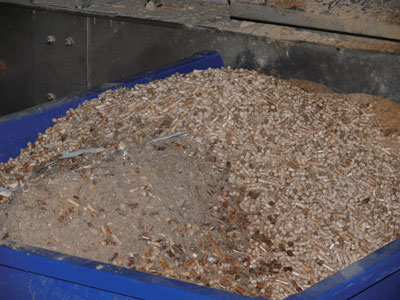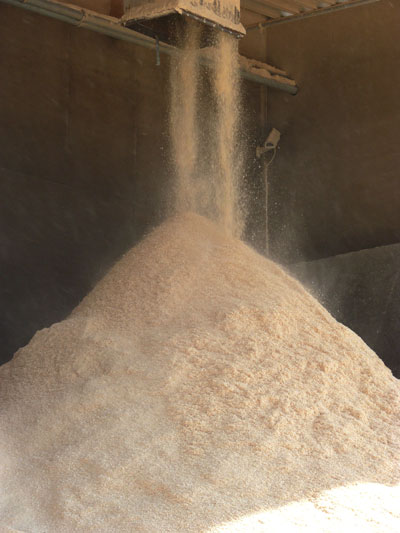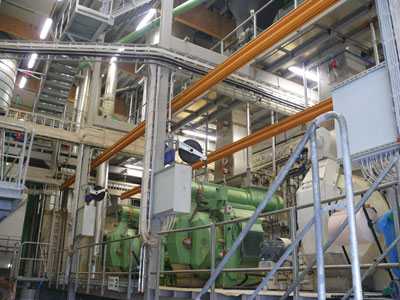
Common Sense
October 16, 2012
By Rob Cruickshank
There is no doubt that pellets provide huge opportunities to reduce our reliance on traditional fossil fuels, such as oil.
There is no doubt that pellets provide huge opportunities to reduce our reliance on traditional fossil fuels, such as oil. Biomass pellets deliver a unique opportunity to increase the use of renewable energy, and cost about 60% less than heating oil, according to the AEBIOM (European Biomass Association). In Canada, this industry continues to grow but there are a number of safety hazards associated with it, including the risk of fire and explosion. Fires in biomass pellet plants are increasingly common. However, the appropriate fire protection system can have a significant impact on mitigating risks.
 |
|
| Operating procedures and stock control measures should include turning the biomass fuel over at least once a week to keep the fuel aerated and cooled, a strategy that minimizes the chance of self ignition.
|
Here is a sampling of the most common fire risks and tips to reduce your exposure:
Waste Reception and Handling
Large quantities of solid or liquid fuel are often stored close to the incineration plant, and the heat generated by microbial activity builds up and can cause the fuel to ignite. The simplest way to avoid this is to ensure that the fuel bunker is constructed in fire-resistant, steel-reinforced concrete and is more than 15 m away from the main process building. This ensures that a fire in the fuel bunker will cause minimal local damage and not spread to the main processing plant. Operating procedures and stock control measures should include turning the biomass fuel over at least once a week to keep the fuel aerated and cooled, which minimizes the chance of self ignition.
Shredders run the risk of a dust explosion; thus, shredders and the enclosures should be designed to resist blockages in the chutes where the waste can absorb water and expand.
Furnace
The furnace unit may include a fossil fuel burner head – if it does, it must include adequate combustion controls such as flame failure detection, air purge controls and fuel double valve isolations. There should be sprinkler heads over the furnace burner heads to protect against fuel spills that could ignite.
Steam Turbine
The lube oil used to maintain the temperature and conditions of the bearings can spray over the hot steam turbine casing and cause a fire. It’s often not the fire itself that causes the most damage, but isolating the lube oil in the turbine. Installing fire-resistive cables for the electrical lube oil supply pumps is one way to minimize risks. Lube oil sprays can be minimized by using pipe standards that include minimum flanged pipelines, positioning spray guards over flanges to control any lube oil spray, and installing high-pressure (supply) lube oil pipelines within low-pressure (return) lube oil pipelines. In addition, all areas beneath the turbine generator operating floor that are subject to oil flow, oil spray or oil accumulation should be protected by an automatic sprinkler or foam-water sprinkler system.
Utility Systems
Oil filled transformers, which are typically associated with turbine generators and old units, are riskier than dry resin units because the oil can burn or explode. It’s recommended that fire protection systems include blast walls or, in some cases, appropriate spatial separation, and complete water spray impingement on all exposed exterior surfaces, providing a water density of 10.2 mm/m2.
 |
|
| Shredders run the risk of a dust explosion and should be designed to resist blockages in the chutes where the waste can absorb water and expand. |
|
 |
|
| Fires in pellet plants are increasingly common; however, the appropriate fire-protection system can have a significant impact on mitigating risks. |
Fires in electrical, control and cable rooms are often limited to small material losses but can mean significant interruptions to the business. Fire protection systems should include adequate compartmentalization of cables and installation of cable sealing through the walls. Cable sealing material used should be fire-resistant cement. Thermographic camera inspections should be carried out annually to identify hot spots on cables or electrical cabinets. Air-aspirated early warning smoke detection systems are an option for control and electrical rooms – this system is very sensitive to smoke particles before the fire fully develops, giving an operator a chance to extinguish the fire before it starts. Automatic sprinkler systems designed to a density of 12.2 mm/min. are recommended.
Diesel generators have the potential for fire, mainly due to crank failure. It’s recommended that the generator be installed in a location where there is little opportunity for a fire to spread – often, the only option is a fire-resistant enclosure.
Cooling towers can be susceptible to fire if a wooden construction dries out during a maintenance period. The cooling tower should be made of non-combustible steel or concrete, or should be separated either by spatial separation of approximately 15 metres or by a four-hour firewall.
Fuel gas handling systems are critical to the combustion process, and combustible elements are typically minimal. If the incineration operation and the fuel gas handling system have been properly designed, there should be no issues.
construction standards
All construction materials used in pellet production plants should be non-combustible, including all composite panel insulation. Composite panels should be rated for two-hour fire resistance using mineral wool rather than fire retarding foam. The walls separating fuel storage from the rest of the plant should be concrete, providing two-hour fire separation.
All plants should include a combination of passive fire protection, which attempts to contain the fire or slow the spread, and active fire protection, which typically includes a fire detection system such as an automatic fire sprinkler or gaseous fire suppression.
Rob Cruickshank is practice director, Construction & Renewable Energy, with RSA Canada.
Print this page